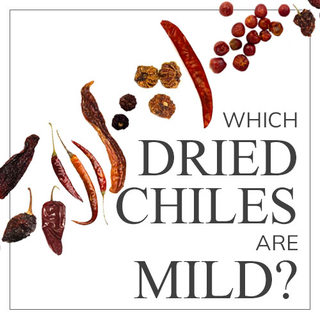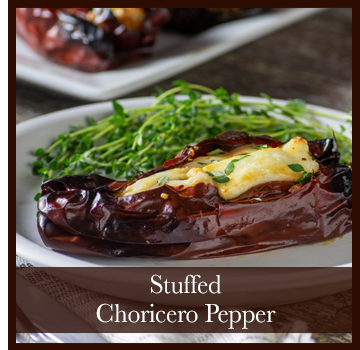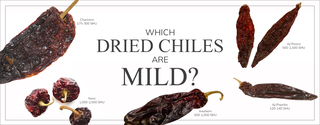Which Dried Chiles Are Mild?

Which Dried Chiles Are Mild
The Bell Pepper is considered the mildest dried chile, with a Scoville Heat Unit (SHU) rating of 0. Bell peppers, Capsicum annuum, are members of the nightshade family and are sometimes classified with other less pungent pepper varieties as "sweet peppers". After the bell pepper the next 5 mildest dried chiles are Aji Paprika (120 – 140 SHU), Choricero (175 – 300 SHU), Nora (500 – 1,000 SHU), Anaheim (500 – 1,000 SHU), and Aji Panca (500 – 1,500 SHU).
The heat of dried chile peppers ranges from 0 SHU up to 2,200,000 SHU. We consider chiles that fall in the range of 0 – 2,500 SHU to be mild, while chiles in the 2,500 – 60,000 SHU range to be medium heat.
The chemical compound capsaicin (8-methyl-N-vanillyl-6-nonenamide) is the active component of chile peppers, and these plants belong to the genus Capsicum1. Dr. Paul Bosland, Regents Professor Emeritus of Horticulture at New Mexico State University, spent his 33-year career there studying the genetics of chile peppers. He co-founded NMSU’s nonprofit Chile Pepper Institute and ran the University’s chile breeding and genetics research program. Dr. Bosland tells us “Generally, the smaller the pepper, the hotter the pepper. There is a biological reason for that. In most peppers, the heat is found only in what’s called the cross walls or placenta, where the seeds are attached--the ribs of a pepper. The walls of the fruit do not have capsaicin production, so a big fruit has diluted capsaicin while a small fruit has concentrated capsaicin”2. This is why the milder chiles tend to be larger in size.
It’s About The Flavor Not The Heat
Just because a chile is mild does not mean it lacks flavor. A chile pepper produces different flavors and heat levels depending on where they are in their growing stage. If allowed to reach full maturity, a chile tends to possess a more complex flavor, often sweeter with fruitier notes, and a richer aroma. The same chile picked in its immature state tends to be vegetal and grassy with a clean aroma; think red jalapenos vs green jalapenos. Flavor compounds develop more completely as the chile ripens, so the flavor will be fuller, sweeter, and juicier after the chile has reached its most mature stage. Milder chiles often have express a wider range of flavor complexities than the hottest dried chiles since they have been bred to accentuate that flavor; many of the hotter types of chiles have been bred to maximize their heat.
depending on where they are in their growing stage. If allowed to reach full maturity, a chile tends to possess a more complex flavor, often sweeter with fruitier notes, and a richer aroma. The same chile picked in its immature state tends to be vegetal and grassy with a clean aroma; think red jalapenos vs green jalapenos. Flavor compounds develop more completely as the chile ripens, so the flavor will be fuller, sweeter, and juicier after the chile has reached its most mature stage. Milder chiles often have express a wider range of flavor complexities than the hottest dried chiles since they have been bred to accentuate that flavor; many of the hotter types of chiles have been bred to maximize their heat.
Chiles can display a variety of flavors; there are at least 20, with some of the most common being spicy, fruity, sweet, smoky, earthy, pungent, and grassy. Chile peppers do not typically have just a single flavor. Most exhibit a nuanced interplay of flavor notes. For example, Aji Panca chiles have a fruity, berry like flavor with aromatic, smoky taste, and a mild lingering heat. Break away from eating chiles for the eat and get to know mild chiles, to experience the subtle flavors that these peppers can add to meals.
Correlations to heat tolerances can also be found in cuisine preferences. Those that like spicy heat tend to gravitate towards Mexican, African, and Southeast Asian cuisine. People who prefer their chile peppers milder are drawn to the peppers and cuisines of Columbia, Puerto Rico, Spain and Venezuela, which have a less aggressive heat profile.
If some of the mild or medium heat level chiles are still too hot for you there are ways to make dried chiles less spicy.
Why Some People Can’t Tolerate Hot Chiles
Researchers from the University of Helsinki did a study of twins and found that 18 to 58% of the pungency sensation is genetic3. John Prescott, Editor of Food Quality and Preference, the leading journal for sensory/consumer science has stated that "People with different trigeminal fibers do feel different levels of heat. What could be extremely painful to one person may be far less painful to another. That’s genetically determined4.”
According to the Cleveland Clinic the trigeminal nerves are responsible for sending pain, touch, and temperature sensations from your face to your brain. It's a large, three-part nerve in your head that provides sensation. One section called the mandibular nerve involves motor function to help you chew and swallow5.
References
1, 4 Zhang, C. (2016, December 28). Why some people can tolerate the world’s hottest pepper. Scienceline. Retrieved May 25, 2022/
2 All About Chile Peppers | Good to Know & How to Grow (2022, March 11). Joe Gardener® | Organic Gardening Like a Pro. Retrieved May 21, 2022.
3 Törnwall, O., Silventoinen, K., Kaprio, J., & Tuorila, H. (2012). Why do some like it hot? Genetic and environmental contributions to the pleasantness of oral pungency . Physiology & Behavior, 107(3), 381–389.
5 Trigeminal Nerve: Trigeminal Neuralgia, Facial Pain, Conditions. (2021, June 4). Cleveland Clinic. Retrieved May 25, 2022.

